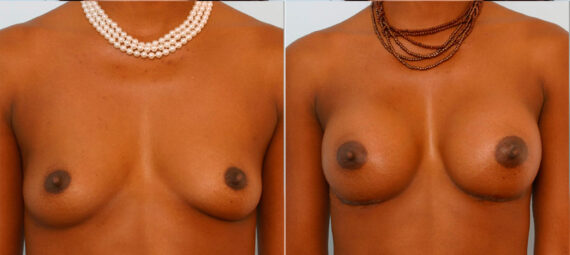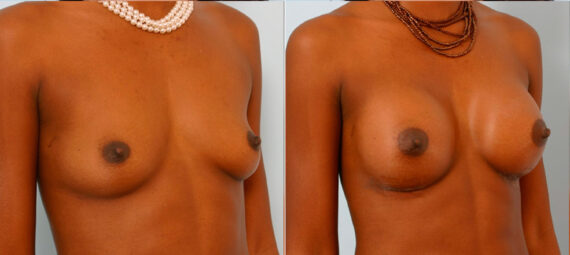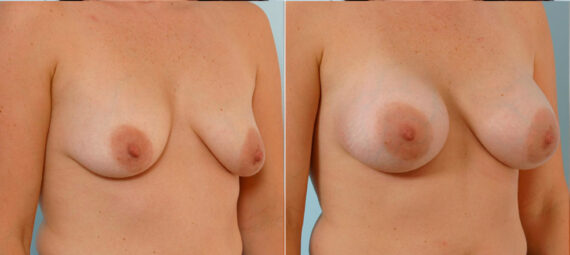If you are considering your options for a breast augmentation, saline breast implants offer a customizable approach to breast augmentation, prioritizing patient safety and aesthetic appeal. Dr. Vitenas applies his surgical expertise and industry standards to enhance results for individuals pursuing cosmetic breast procedures.
Dr. Vitenas uses detailed preoperative planning and advanced surgical techniques to meet each patient’s individual anatomical needs and personal goals when performing saline implant procedures. He believes in putting patients first and making informed decisions in cosmetic breast surgery.

The Essentials of Saline Breast Implants in Surgery
Saline breast implants, key in breast augmentation and reconstruction, consist of a silicone shell filled with sterile saline (salt water). They are either empty or pre-filled during surgery, allowing volume adjustments to align with the patient’s body dimensions and preferences. These implants have become pivotal in achieving natural-looking results, emphasized by Dr. Vitenas, a leader in breast augmentation. He underscores their role in ensuring patient safety and satisfaction.
In contrast, silicone breast implants are pre-filled with silicone gel, often considered for their natural feel. Distinct features of each type include:
- Filling: Sterile saline in saline implants; silicone gel in silicone implants.
- Consistency: Saline mimics water; silicone resembles human fat.
- Incision Size: Smaller for saline (filled post-placement); larger for silicone (pre-filled) depending on size of implant chosen.er for saline (filled post-placement); larger for silicone (pre-filled).
- Rupture Detection: Saline leaks are obvious as the implant deflates; silicone leaks are subtler, potentially requiring MRI detection.
- Adjustability: Saline volume is modifiable during surgery; silicone’s is fixed requiring the surgeon to have a large stock of all sizes available.
- Feel: Saline implants are firmer as water is a non-compressable substance, whereas silicone offers a softer, more natural feel.
Choosing between the two types depends on individual body shape, aesthetic goals, and personal preferences. Saline implants offer adjustability and easier leak detection, while silicone implants provide a more natural feel. The decision is highly personal for each individual pursuing breast augmentation, with considerations of safety, aesthetic outcome, and the unique advantages of saline implants.
Choosing Saline Breast Implants
Who May Consider Them?
Saline implants are often chosen by women seeking breast enhancement surgery for various reasons. These include:
- Natural breast tissue: Women with ample natural tissue may opt for saline implants to enhance breast size and shape.
- Preference for saline: Some patients prefer the safety profile of saline, especially considering concerns about silicone ruptures.
A consultation with a qualified plastic surgeon is vital to discuss whether saline breast implants are appropriate for your case.
Preoperative Strategies for Saline Implants in Breast Surgery
Patient Eligibility and Health Assessment
During the initial consultation, Dr. Vitenas assesses the patient’s health, discussing any autoimmune disorder risks and ensuring suitability for breast implant surgery.
Choosing the Right Implant Size and Profile
The success of saline breast augmentation largely hinges on the careful selection of the implant’s size and profile, tailored to complement the patient’s unique physical characteristics and aesthetic aspirations.
Factors to consider include:
- The individual’s body frame: Acknowledging the proportionality between the patient’s body frame and the implant size is critical for a balanced appearance.
- Tissue quality: Assessing the integrity and characteristics of the breast tissue is essential to ensure compatibility and longevity of the implant.
- Personal aesthetic preferences: Understanding the patient’s vision for their post-operative appearance guides the selection process.
The type of implant profile also plays a pivotal role in defining the final breast shape and projection, shaping the overall contour and prominence.
Saline Implant Placement Techniques in Breast Surgery
Surgeons choose specific sites for inserting saline breast implants to achieve good aesthetics and effectiveness. The typical sites are:
- Inframammary: Under the breast, concealed by its natural fold, this is the most commonly used incision because it carries the lowest complication rate and the greatest predictability of controlled success. Approximately 80% of all breast augmentation procedures done worldwide are through this approach.
- Periareolar: Around the nipple, merging with the edge of the areola, this incision can provide an excellent barely noticeable scar but should only be used one time. Frequently a secondary surgery will require a inframammary incision, whereas if the infromammary approach was used originally it cna be used again.
- Transaxillary: In the armpit to prevent scars on the breast, this approach is popular with young first time implant patients. It carries the highest reoperation rate because it does not allow the level of control of the pocket the inframammary approach does.
- Transumbilical: Through the navel, but this is only for saline implants and is very rarely used because of its unpredictatble results. This approach has all but been abandoned by most plastic surgeons.
The choice of the incision site takes into account the patient’s breast cavity, the surgeon’s expertise, and other factors.
Implants can be placed in two main ways:
- Subglandular: The implant goes between the breast tissue and chest muscle. This approach is best when the patient has adequate soft tissue in the upper pole to cover the implant. Otherwise the upper edge of the implant my be more visible.
- Submuscular: The implant is under the pectoral muscle. This can give a more natural look and feel, especially for those with less body fat and is hte procedure of choice for most patients.
The placement affects the look and feel of the implant. The best choice varies based on body type, activity level, and what the patient hopes to achieve. The surgeon’s advice will be tailored to the patient’s unique situation, considering the safest option.
Postoperative Care for Saline Breast Implants
Guidelines After Surgery
Patients must adhere to the following instructions after saline breast implant surgery:
- Rest to speed up the healing process.
- Move the implants in the pockets as instructed.
- Use cold compresses and prescribed medication to control pain and decrease swelling.
- Take care of the incision site as per the surgeon’s recommendations to avoid infections.
Monitoring for Complications
Be attentive after your surgery and look for these signs of possible issues:
- Swelling, redness, or warmth that could suggest an infection.
- Ongoing pain or an altered shape of the breasts may hint at ruptured implants and need urgent care.
- Be aware of any fluid build-up near the implants.
- Contact Dr. Vitenas if the tissues around the implant thicken or harden, as this may be capsular contracture.
- Regular doctor visits are crucial to check on the implants’ condition.
Complication Management in Saline Breast Implant Surgery
Identifying Complication Signs Early
It is important to notice early signs of complications after getting saline breast implants. Look out for continuous redness, swelling, or pain which might indicate an infection. Surgeons should teach patients how to check their implants and stress the need to report any unusual changes quickly.
Infection and Capsular Contracture Management
Immediate antibiotic treatment is essential for infections. If unresolved, additional surgery to remove the implant temporarily might be necessary. Capsular contracture, characterized by the hardening of tissue around the implant, requires timely intervention, possibly including medication, massage, or surgery to remove or loosen the constricted tissue.
Handling Implant Rupture
If a saline breast implant ruptures, the body can safely absorb the saline. However, a rupture still needs surgery to put in a new implant. If you notice your breast shape changing or deflating, see a doctor. Confirming ruptures leads to planning a quick surgery to replace the implant and help you return to your routine quickly.
Enhancing Aesthetic Results in Saline Breast Implant Surgery
Surgeon expertise plays a vital role in achieving good results with saline breast implant surgeries. Well-practiced surgeons use careful incision methods and handle the breast tissue with care. This leads to better shape and symmetry. Often, a surgeon may perform a breast lift alongside the implant procedure to improve the appearance of sagging, resulting in a youthful outcome. Each surgery is customized for the patient’s body, aiming for a natural look.
Technological progress in saline breast implants has also helped in improving aesthetic results. Newer models of implants feature stronger shells and adjustable fill levels that let patients choose their preferred size and feel, similar to silicone breast implants. Shapes of implants have also been refined to fit the body better, improving the overall look. When used by an expert surgeon, these advancements meet patient expectations.
Ethical Best Practices in Saline Implant Surgery
Informed Consent
Ethical standards, especially informed consent, are pivotal in saline implant surgery. Surgeons must ensure patients comprehend the surgery, its risks, and expected outcomes. This includes explaining the differences between saline and other types of breast implants, like silicone gel and gummy bear implants, each with unique features like silicone shells. Patients should understand that while saline implants enhance breast appearance, they may not fulfill every expectation. Pre-surgical clarity is crucial to avert postoperative disappointment.
Risks, Aesthetic Goals
Surgeons bear the responsibility of balancing the patient’s aesthetic desires with surgical risks. This involves a candid discussion about the benefits and potential complications of saline implants, emphasizing patient safety. Surgeons should inform patients about their body’s possible reaction to different types of breast implants during the consultation for breast enhancement and stress the need for realistic expectations. Open discussions about risks build trust and ensure decisions are health-centered.
Considering saline breast implants is a significant decision that should be made with guidance from a qualified expert. Dr. Vitenas offers a wealth of knowledge and profound expertise in breast surgery to guide you through every step, ensuring the best possible outcomes.
To give your vision the care and precision it deserves, schedule a consultation with Dr. Vitenas. Seek guidance from a highly skilled expert in aesthetic breast surgery to confidently pursue your desired breast enhancement.




